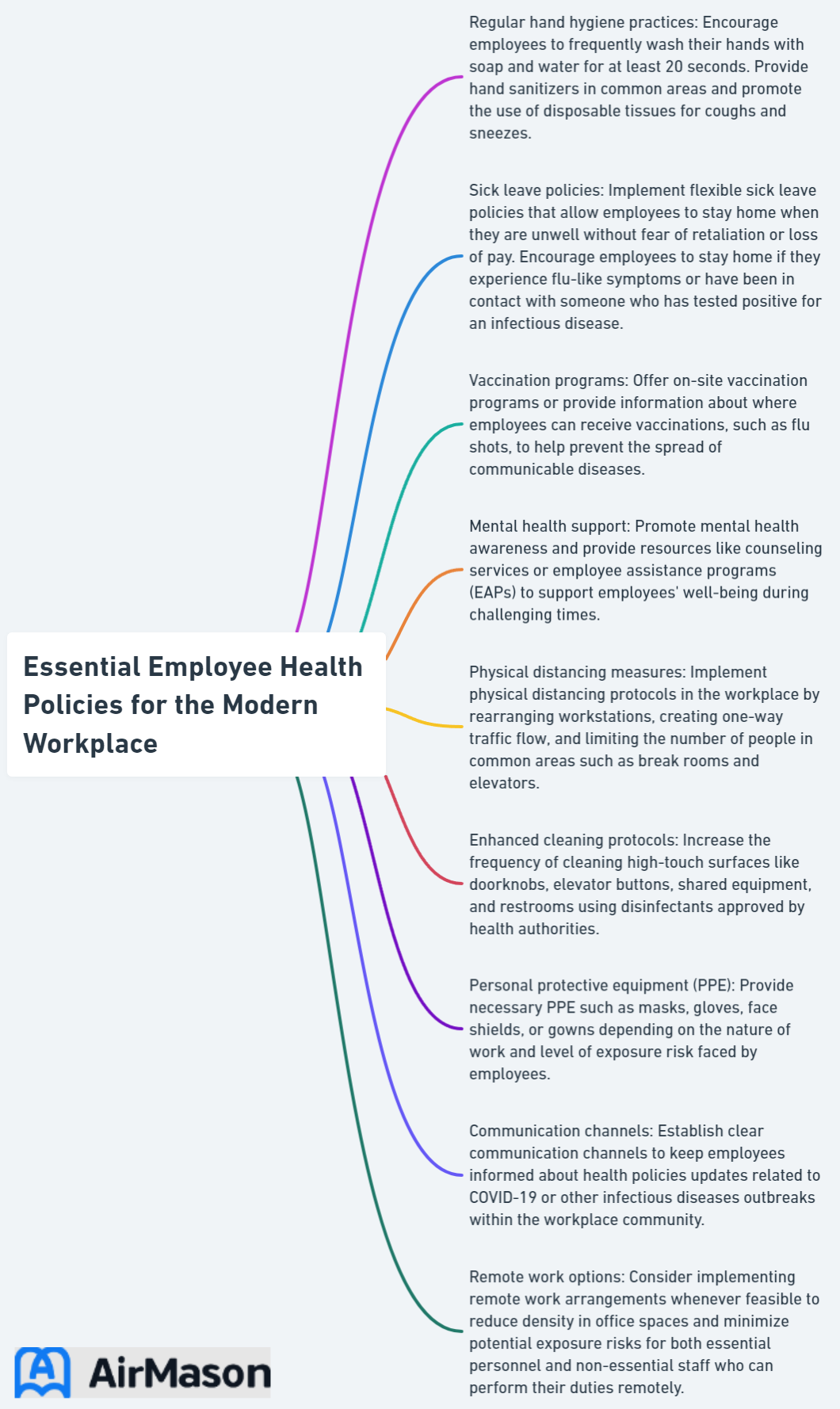
In today’s fast-paced work environment, maintaining employee health is more important than ever. The modern workplace demands a fresh approach to prioritizing employee well-being, from physical fitness to mental health, and from work-life balance to emergency preparedness. The result? A healthier, happier, and more productive workforce. Ready to transform your organization? Let’s dive into the essential employee health policies for the modern workplace.
Key Takeaways
- Employee health policies are essential for promoting workplace safety, employee wellbeing and productivity.
- These include wellness programs, occupational health & safety regulations, work-life balance initiatives and substance abuse & addiction policies.
- Employers can provide access to healthcare resources through insurance coverage and preventive care services to improve employees’ overall well being.
Employee Wellness Programs
Promoting a healthy workforce relies heavily on employee wellness programs. These comprehensive initiatives can lead to increased productivity, decreased healthcare costs, and enhanced morale among employees.
Successful wellness programs may include on-site fitness centers, yoga classes, smoking cessation programs, access to mental health support, and other facilities.

Work Relationship Policy
Our organization is committed to fostering a positive and collaborative work environment through the implementation of a comprehensive Work Relationship Policy. This policy outlines the expectations and guidelines for professional interactions among team members. By clearly defining the Work Relationship Policy, we aim to promote open communication, mutual respect, and a healthy work atmosphere. This policy underscores the importance of clear communication channels, conflict resolution mechanisms, and the establishment of a supportive work community. Embracing the principles of our Work Relationship Policy ensures that every employee feels valued and contributes to the overall success of our team.
Physical health initiatives
Creating a culture that prioritizes employee health starts with promoting physical well-being. Employers can engage employees in physical health initiatives by offering gym memberships, providing on-site fitness opportunities, and implementing healthy snack options. Inclusion of such initiatives can help employers cultivate a workforce that’s both healthier and more productive.
Mental health support
Mental health support is equally important in maintaining a healthy workforce. Companies can implement mental health support programs like Employee Assistance Programs (EAPs), which provide access to counseling, mental health days off, and digital technology for tailored support.
These programs which focus on employees’ mental well-being can result in increased job satisfaction and decreased burnout.
Benefits of wellness programs
The benefits of wellness programs extend beyond individual well-being. Research shows that companies with successful wellness programs experience higher employee engagement, job satisfaction, and reduced turnover rates. Moreover, wellness programs yield an impressive return on investment, with employers reaping an average ROI of 47%.
In summary, the investment in wellness programs leads to a workforce that is healthier, happier, and more productive.
Occupational Health and Safety Policies

Ensuring a safe work environment for all employees is the main objective of occupational health and safety policies. These policies involve hazard identification, employee training, and incident reporting, with the goal of minimizing risks and maintaining compliance with health and safety regulations.
Hazard identification and risk assessment
A systematic approach to hazard identification and risk assessment is essential in maintaining a safe workplace. Investigations into incidents and determination of underlying hazards enable employers to assess potential risks and formulate plans for their mitigation. This process helps to protect employees from potential harm and ensures the organization’s compliance with safety regulations.
Employee training and education
Employee training and education play a pivotal role in promoting workplace safety. Ensuring employees are aware of safety regulations and updated on the latest safety practices helps create a culture of safety among the workforce.
Comprehensive training provided by employers can decrease the risk of accidents and injuries, thereby promoting a safer work environment.
Incident reporting and investigation
Incident reporting is a vital component of workplace safety. Encouraging incident reporting allows employers to:
- Identify and address potential hazards
- Take measures to prevent recurrence of similar incidents
- Create a culture of safety within the organization
- Protect employees
- Maintain compliance with relevant regulations
Work-Life Balance Policies

A healthy work-life balance is key to employee well-being, job satisfaction, and productivity. Policies that promote work-life balance, such as flexible work hours and remote work options, enable employees to manage their personal and professional lives more effectively.
Flexible work hours
Flexible work hours can significantly improve employee well-being by reducing stress and enhancing job satisfaction. Companies like Dell and OfficeRnD have successfully implemented flexible work hours, resulting in improved work-life balance and increased professional performance.
The provision of flexible work schedules can lead to a more satisfied and productive workforce.
Remote work options
Remote work options offer numerous benefits, such as reduced commuting time and increased flexibility. However, they may also present challenges, such as feelings of isolation and difficulty maintaining work-life balance.
Employers can assist employees in overcoming these challenges and reaping the benefits of remote work by providing essential tools and technologies, and nurturing a supportive work culture.
Encouraging time off and vacations
Vacations play a vital role in employee productivity and well-being. Regular time off can reduce stress, increase happiness, and improve overall health. Companies with unlimited vacation policies, such as Netflix, have reported higher job satisfaction and decreased burnout among employees.
Encouragement of time off and vacations allows employers to support employee well-being and cultivate a more productive workforce.
Substance Abuse and Addiction Policies

Policies on substance abuse and addiction play a crucial role in supporting employees dealing with addiction, while also ensuring a safe workplace. These policies focus on drug testing, employee assistance programs, and maintaining confidentiality to ensure the well-being of employees and compliance with relevant regulations.
Drug testing and prevention
Drug testing is a common method for detecting substance abuse in the workplace. It can be a valuable tool in creating a safe work environment and reducing the risk of accidents and injuries.
Employers must ensure that their drug testing programs are legally compliant and respect employee privacy.
Employee assistance programs
Employee assistance programs (EAPs) offer confidential counseling and support for employees dealing with substance abuse and other personal issues. These programs can provide valuable resources and assistance to employees in need, helping them overcome addiction and maintain their well-being.
Confidentiality and privacy concerns
Employers must respect confidentiality and privacy when addressing substance abuse in the workplace. Compliance with federal regulations, such as the Substance Abuse Confidentiality Regulations and HIPAA regulations, ensures that employees’ personal information remains protected. Maintaining confidentiality enables employers to support employees battling addiction and foster a safe, supportive work environment.
Overtime Policy
Our organization’s commitment to employee well-being is reflected in our comprehensive overtime policy. At the heart of our operations, the “overtime policy” serves as a guiding framework to ensure fairness, transparency, and employee satisfaction. We understand the importance of recognizing and compensating employees for their additional efforts beyond regular working hours. This policy not only outlines the procedures for requesting and approving overtime but also emphasizes our dedication to maintaining a healthy work-life balance
Ergonomics and Workplace Design

Ergonomics and workplace design policies aim to create a comfortable and efficient work environment. Promotion of employee health and productivity can be achieved by focusing on proper workstation setup, encouraging movement, and incorporating ergonomic equipment.
Proper workstation setup
A proper workstation setup is crucial for employee comfort and efficiency. Employers should ensure that chairs are well-adjusted, keyboards and mice are positioned correctly, and monitors are placed at an appropriate distance and height. Optimizing workstation ergonomics can help employers minimize the risk of musculoskeletal disorders and enhance employee well-being.
Encouraging movement and breaks
Promoting movement and breaks throughout the workday can have numerous benefits, such as reducing the risk of sedentary lifestyle-related health issues and improving employee morale. Employers can encourage movement and breaks by implementing active breaks, providing incentives, and fostering a positive attitude toward breaks.
Implementing ergonomic equipment
Ergonomic equipment, such as adjustable standing desks and ergonomic chairs, can play a significant role in reducing the risk of workplace injuries and promoting employee comfort by following proper guidelines.
Investment in ergonomic equipment can illustrate an employer’s commitment to employee health and well-being.
Mental Health Policies

Mental health policies are essential in promoting employee well-being and productivity. Employers can assist employees in managing their mental health and sustaining a positive work-life balance by identifying common stressors, providing resources and support, and nurturing a supportive work environment.
Identifying common stressors
Common workplace stressors, such as excessive workload, job insecurity, and conflicts with colleagues, can have a detrimental effect on employee mental health. Recognizing these stressors and implementing strategies to tackle them can help employers cultivate a healthier, more productive workforce.
Providing resources and support
Supporting employee mental health goes beyond simply identifying stressors. Employers can provide resources and support, such as access to Employee Assistance Programs (EAPs) and online mental health resources, to help employees manage their mental health and well-being.
Fostering a supportive work environment
Creating a supportive work environment is vital for employee mental health. Employers can foster a positive work culture by facilitating open communication, providing opportunities for professional growth, and acknowledging employees’ efforts.
Investment in a supportive work environment can lead to enhanced employee well-being and improved productivity.
Emergency Response and Preparedness
Workplace safety during emergencies is assured through emergency response and preparedness policies. These policies involve:
- Developing an emergency action plan
- Training employees in emergency procedures
- Regularly reviewing and updating policies to maintain compliance with relevant regulations.
Developing an emergency action plan
An effective emergency action plan outlines the steps to be taken during critical events, such as fires or natural disasters. Employers, in collaboration with local authorities, can ensure employees’ familiarity with evacuation procedures and create a safer environment during emergencies by incorporating full, partial, and shelter-in-place evacuations.
Training employees in emergency procedures
Training employees in emergency procedures is crucial for ensuring they are prepared to respond effectively during a crisis. Comprehensive training provided by employers can help reduce the risk of accidents and injuries, thereby fostering a safer work environment during emergencies.
Regularly reviewing and updating policies
Regularly reviewing and updating emergency response policies is essential for maintaining their effectiveness and addressing any changes in the organization or potential risks. Employers should review and update their policies at least once a year to ensure compliance with relevant safety regulations and adapt to evolving workplace needs.
Employee Health Benefits
Employee health benefits, such as health insurance coverage and preventive care services, provide employees with access to essential healthcare resources and promote overall employee well-being. These benefits not only support employee health but also demonstrate an employer’s commitment to their workforce.
Health insurance coverage
Health insurance coverage is a vital employee benefit that provides access to necessary healthcare services and alleviates financial strain. The average annual premium for employer-provided health insurance in 2022 was $7,911 for single coverage and $22,463 for family coverage, with employers covering approximately 82-83% of these premiums.
Support for employee health and well-being can be shown by employers offering health related policies, such as health insurance coverage with tax exempt status.
Preventive care services
Preventive care services, such as routine check-ups, vaccinations, and screenings, play a crucial role in employee well-being. By identifying and addressing potential health issues before they become more serious, preventive care services can improve overall health and reduce the risk of illness and injury.
Providing access to these essential human services and facilities enables employers to promote employee well-being.
Summary
In conclusion, prioritizing employee health is essential for creating a productive, satisfied, and healthy workforce. By implementing comprehensive wellness programs, occupational health and safety policies, work-life balance policies, substance abuse and addiction policies, ergonomics and workplace design, mental health policies, emergency response and preparedness, and employee health benefits, employers can transform their organization into a thriving, supportive, and successful workplace. Remember, investing in employee health is not only good for your employees but also good for business.
Policy for Working Remotely
Our “Policy for Working Remotely” is designed to provide clear guidelines and expectations for employees engaging in remote work. This policy aims to establish a framework that ensures productivity, communication, and collaboration while working outside the traditional office environment. Employees are required to adhere to the “Policy for Working Remotely” to maintain a cohesive and efficient workflow. Regular check-ins, utilization of virtual communication tools, and compliance with security protocols are essential components of this policy. We encourage all team members to familiarize themselves with the “Policy for Working Remotely” to create a seamless and successful remote work experience.
Frequently Asked Questions
What are some examples of health policies?
Examples of health policies include food safety policies, smoke-free policies, and policies prohibiting tobacco and alcohol use at the workplace. These policies help to reduce risks of deaths and illnesses, prevent smoking initiation, improve oral health, and promote healthier lifestyles.
What are the occupational health and safety policies and procedures?
Workplace health and safety policies provide guidelines to promote employee well-being and ensure compliance with regulations. They cover preventative actions, emergency management, and additional measures to actively promote safety.
What is the food employee health policy in Ohio?
In Ohio, all food employees and conditional employees must be informed of their responsibility to report any health conditions that can be transmitted through food to the person in charge.
What are some effective strategies for promoting physical health in the workplace?
Employers can effectively promote physical health in the workplace by offering gym memberships, providing on-site fitness opportunities, and implementing healthy snack options.
How can employers support employees in establishing a productive remote work environment?
Employers can promote productivity by maintaining communication, setting clear expectations, providing necessary tools and technology, and creating a supportive work environment.